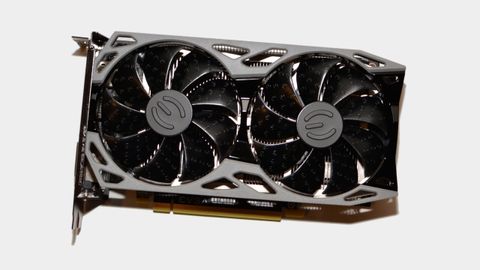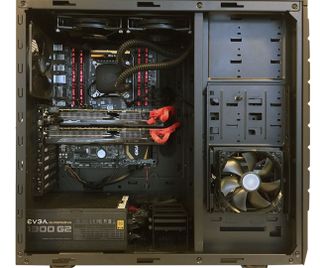Our Verdict
The GTX 1660 Super is a good blend of price and performance that almost makes the 1660 Ti look redundant, and the lower price makes this an easy recommendation for the $225 crowd.
For
- Good 1080p performance
- Better value than 1660 Ti
- Proven Turing architecture
Against
- Missing RTX features
- Crowded price point
PC Gamer's got your back
Earlier this year, Nvidia launched its new GTX 16-series with the GTX 1660 Ti, GTX 1660, and GTX 1650 seeking to join the ranks of the best graphics cards. The lack of ray tracing hardware is an interesting change after last years RTX 20-series, but it does make sense for the mid-range and lower markets. When Nvidia refreshed the RTX lineup with the Super models, I didn't expect to see that extend into the GTX range, yet here we are. The GTX 1660 Super is a thing that now exists, leveraging the same Turing architecture and TU116 GPU, but it certainly leaves me scratching my head. All in the name of competition I suppose.
I'm not saying the card is bad by any means, but it ends up overlapping the GTX 1660 Ti in many respects. It still has the GPU core counts and clockspeeds of the vanilla GTX 1660, but now it gets GDDR6 memory—which was one of the primary differentiators between the 1660 and 1660 Ti. Even more curious, the GDDR6 memory is clocked at 14Gbps compared to the 12Gbps speed on the 1660 Ti. Basically, it's weird to have a lower tier card that's both better and worse than an existing higher tier card. At least the price is lower, which brings me to the official specs overview.
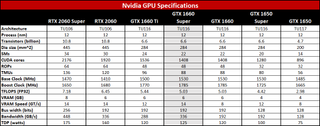
The main specifications are no surprise. It's the same TU116 GPU, still with 22 SMs enabled (out of potentially 24 SMs), now with 14Gbps GDDR6. I questioned the lack of 14Gbps GDDR6 on the 1660 Ti when it came out, and assumed it was mostly because it wasn't really necessary, but it would have made a lot more sense to equip that card with faster VRAM and then have the 1660 Super use 12Gbps. That's not how things played out, however, and now we end up with an even more crowded budget to mid-range set of Nvidia offerings.
It's important to note that the 1660 Super (and 1650 Super) are intended to coexist with the other GTX 16-series GPUs, rather than replacing anything. That means Nvidia now has five GTX 16-series parts instead of three. I've included what we know of the GTX 1650 Super in the table as well, plus the 2060 and 2060 Super to show what you get with the next level above the GTX cards. It's worth pointing out that the 1650 also uses TU116 now—it was necessary to use the larger die in order to get the improved NVENC hardware, since Nvidia didn't include that in TU117.
There's a reason for these new GTX Super cards, of course, and that reason is AMD. Specifically, AMD recently launched the OEM version of the Radeon RX 5500, and consumer models are expected to arrive shortly. Combined with prices dropping over the past six months on the existing RX 590 cards and it seems Nvidia wants to improve the way its cards stack up against AMD's current and future offerings. At least that's how I see things; I'm sure Nvidia would say this was always the plan.
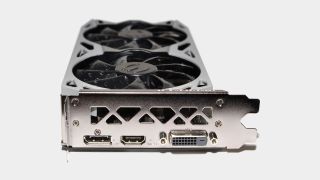
If you already have a GTX 1070, 1070 Ti, or 1080, you're not going to want to bother downgrading to the 1660 Super.
The other interesting aspect about the GTX 16-series is the lack of hardware ray tracing features. There's driver support for DirectX Raytracing (DXR), but generally speaking you won't get much above 30 fps even at 1080p with the GTX 1660 models. With the RTX 2060 now starting at around $320 (and I've seen sales drop the price as low as $300), the GTX 1660 Ti is in a tough spot. I'd almost always encourage gamers to upgrade to the RTX 2060 over the 1660 Ti, since it's only about $50 more. With the 1660 Super price of $229, that's a big enough jump that the Super feels like a viable option.
There's still the problem of the previous generation cards, as well as the existing 1660 cards. Most of Nvidia's GTX 10-series parts are only available second-hand these days, but if you already have a GTX 1070, 1070 Ti, or 1080, you're not going to want to bother downgrading to the 1660 Super. The same goes for AMD graphics cards at the Vega 56 level or higher. The current generation mid-range end up competing against the previous generation mid-range and high-end GPUs, and usually they're not able to surpass the latter.
Meanwhile, official prices on most of Nvidia's Turing cards are about 10 percent higher than street prices, so a $229 1660 Super is only $20 less than the cheapest GTX 1660 Ti. With Black Friday deals looming on the horizon, I expect we'll see some GTX 1660 Ti cards actually drop below the newly released GTX 1660 Super. Hopefully it's pretty obvious that the 1660 Ti is generally the better card if pricing is anywhere close to equal. And if you're worried about the 12Gbps GDDR6 compared to 14Gbps on the Super, don't—the 1660 Ti cards I've tested can all overclock the VRAM to 14Gbps (and often 15Gbps).
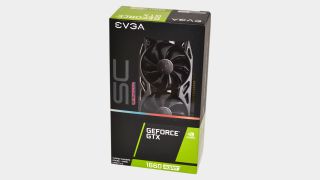
Meet the EVGA GTX 1660 Super Ultra SC
That sets the stage for our benchmarks and analysis of the GTX 1660 Super. For this review, Nvidia shipped me the EVGA GTX 1660 Super Ultra SC, which means it comes with a modest factory overclock. Specifically, it has a boost clock of 1835MHz compared to the reference clock of 1785MHz. That boosts performance a few percent in practice, and while you wouldn't normally notice the difference while playing games, it will certainly show up in the benchmarks.
This EVGA is a pretty standard design, with dual cooling fans and a modest heatsink. With a rated TDP of 125W, there's no real need for an extravagant cooling solution, and jacking up the price runs counter to the whole concept of a mid-range offering. Instead of spending an extra $20-$50 on better cooling and a higher factory overclock, it's better to just move up to the next performance tier—the GTX 1660 Ti in this case. The downside is that the card isn't particularly quiet, measuring 60 dB(A) under load from a distance of 5cm, but that keeps the GPU at a relatively chill maximum core temperature of 74C.
For comparison, a Sapphire RX 5700 Pulse only measured 45 dB(A) in the same test conditions, and even an RX 5700 XT reference card only hit 57 dB(A). The 5700 XT also runs about 10C hotter, leveling off at 84C. The reason for the higher noise levels is pretty simple: EVGA isn't using a particularly robust heatsink, relying instead on fan speeds and airflow to keep the card cool. Even though the 1660 Super uses less than half the power of a 2080 Ti, with a smaller heatsink and no heatpipes it ends up generating a decent amount of noise.
Test Setup
Most of the other cards are reference clocked models, though the RTX 2070, 2080, and 2080 Ti are Founders Edition cards that also have a 90MHz factory overclock. AMD's RX 590, 580, and 570 cards are likewise factory overclocked models, but I don't normally consider differences of less than 5 percent to be particularly meaningful when comparing performance.
I continue to use my standard GPU testbed from about two years ago, with a Core i7-8700K overclocked to 5.0GHz to ensure the CPU isn't a bottleneck in testing. In a few instances an i7-9700K or i9-9900K might be fractionally faster in games, but typically the difference is less than a few percent—even less at 1440p and 4K, and also less when looking at mid-range graphics solutions like the 1660 Super. The PC also uses fast DDR4-3200 CL14 G.Skill memory and SSD storage to ensure the GPU is the limiting factor in performance (as much as possible).
I'm using Nvidia's pre-release 441.07 drivers on the GTX 1660 Super, and I've spot-checked other Nvidia cards to ensure there are no anomalies. Most of the results are about the same, but several games—and Forza Horizon 4 in particular—required retesting with the latest drivers. The AMD GPU results are current as of 19.9.2, with slightly newer 19.10.1 drivers used in The Outer Worlds.
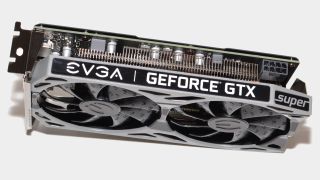
GeForce GTX 1660 Super gaming performance
In keeping with my tradition of adding newer games to the test suite as they become available (and meaningful), I've updated the list since the Sapphire RX 5700 review. Specifically, I dropped Fortnite and added The Outer Worlds, mostly because Fortnite continues to change so frequently that establishing and maintaining a useful benchmark is nearly impossible. This provides a look at performance in recent releases as well as some popular but slightly older games, with the oldest game on the list right now being Total War: Warhammer 2 from late 2017.
The 11 games I'm testing include a pretty even mix of AMD and Nvidia promoted titles, currently with more AMD promoted games. DirectX 12 is utilized in most cases if it's available, though I tested Borderlands 3 in DX11 mode, and Total War: Warhammer 2 in DX11 on Nvidia GPUs. In both cases, that's because the DX11 solution performed better.
Each card is tested at four settings: 1080p medium or equivalent, and 1080p/1440p/4k ultra unless otherwise noted. For the charts below, I'm including the 4K gaming results mostly so you can see how the other GPUs perform, as no one buying a GTX 1660 Super should even be thinking about 4K ultra. Every setting is tested multiple times to ensure the consistency of the results, and I use the best score. Minimum FPS is calculated by summing all frametimes above the 97 percentile and dividing by the number of frames, so that it gives a reasonable representation of the lower end of the performance scale, rather than looking only at the single worst framerate from a benchmark run.
Here are the gaming performance results for the EVGA GTX 1660 Super SC Ultra.
















































Hopefully this comes as a surprise to no one, but the GTX 1660 Super ends up performing just a bit slower than the GTX 1660 Ti in pretty much every test I ran. Overall, the 1660 Super is 3-5 percent slower than the 1660 Ti, and it's about 15-20 percent faster than the vanilla GTX 1660. The faster GDDR6 memory didn't provide the newcomer with any victories, but considering it has a 9 percent deficit in GPU cores that's to be expected.
Practically speaking, there's almost no difference in real-world performance when looking at the 1660 Ti and 1660 Super. Short of running benchmarks, no one is going to be able to discern a 5 percent difference, and tweaking one or two settings down a notch would make up for that deficit. Sure, a heavily overclocked 1660 Ti going up against a stock 1660 Super might show a larger gap, but a heavily overclocked 1660 Super should also come out slightly ahead of a 1660 Ti running reference clocks.
The more pertinent question is why is Nvidia even releasing the 1660 Super? Does it fear AMD's RX 5500, or perhaps the lower prices on the RX 590? I don't know. It's also possible Nvidia is simply able to get GDDR6 memory at prices that are competitive with GDDR5, meaning it can make the switch in memory without changing the bottom line. Whatever the reasoning, the fact remains that the 1660 Super is better value overall. It's officially $50 cheaper than a 1660 Ti—a difference of 18 percent—while performance is within 5 percent:






The GTX 1660 Super doesn't quite claim top honors in the GPU value charts, but it comes close. I suspect both AMD and Nvidia will be happy when the RX 570 supply finally dries up, considering it's been on clearance pricing for most of the past year now. Meanwhile, from a complete system perspective, the 1660 Super and 1660 Ti are basically a wash—the cost of the other components tends to outweigh the GPU.
These value charts can't fully quantify every potential buyer, as for many people raw performance will hold more weight than price. It's why some gamers buy the RTX 2080 Ti, even though it's at the bottom of the GPU value charts and only about half way up the system value charts. I recommend gamers first decide what resolution and settings they want to use, and what level of performance they want. Then look at the cards that meet those targets and only then do the value charts become more useful. Because even though the RX 570 looks like great value, personally I want something that can handle at least 1440p and high to ultra settings.
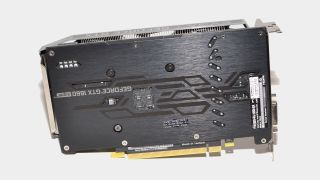
GeForce GTX 1660 Super: similar performance for less money
I have to admit, when rumors started circulating several months back of a 'Super' refresh of the 1660 and 1650, I thought they were bunk. The GTX 16-series is only is only about six months old, and adding GDDR6 to the GTX 1660 basically gets you a 1660 Ti. I was right about the performance, but wrong about the rumors. I'm still not sold on Nvidia's Super branding though. It feels like something my 9-year-old son came up with. "Look, dad, I just made a more powerful robot. I call it the super robot!" The kids will love it. Or maybe I'm just getting old and I've lost touch with how awesome super heroes are.
Of course, we still need to see where AMD's RX 5500 cards land, both in pricing as well as performance. I think the GTX 1650 Super will go up against the RX 5500, based on specs and early performance estimates, which again makes the GeForce GTX 1660 Super a bit of an oddity.
Something else to consider is whether a $230 graphics card will do everything you want. It's basically around GTX 1070 levels of performance, a card from three years ago that was routinely available for $350 (before the cryptocurrency craze screwed pricing up). These days, a 1070 is still fine for 1080p gaming, but with next-gen consoles due out next year with ray tracing features, I think the RTX 2060 and RTX 2060 Super are better long-term investments.
The thing is, while a $50 difference in price isn't that big, particularly in the high-end and extreme markets, for mainstream and budget builds where every cent counts, the GTX 1660 Super is an easy recommendation. It's nearly as fast as its big brother and costs less, and it outperforms anything AMD currently offers in the same price range (it's about 20 percent faster than the RX 590). And it does all that while using less power. If you can't go much over $200 for a graphics card upgrade and you're still running a GPU that's several generations old, say hello to the GTX 1660 Super.
The GTX 1660 Super is a good blend of price and performance that almost makes the 1660 Ti look redundant, and the lower price makes this an easy recommendation for the $225 crowd.
Jarred's love of computers dates back to the dark ages when his dad brought home a DOS 2.3 PC and he left his C-64 behind. He eventually built his first custom PC in 1990 with a 286 12MHz, only to discover it was already woefully outdated when Wing Commander was released a few months later. He holds a BS in Computer Science from Brigham Young University and has been working as a tech journalist since 2004, writing for AnandTech, Maximum PC, and PC Gamer. From the first S3 Virge '3D decelerators' to today's GPUs, Jarred keeps up with all the latest graphics trends and is the one to ask about game performance.
